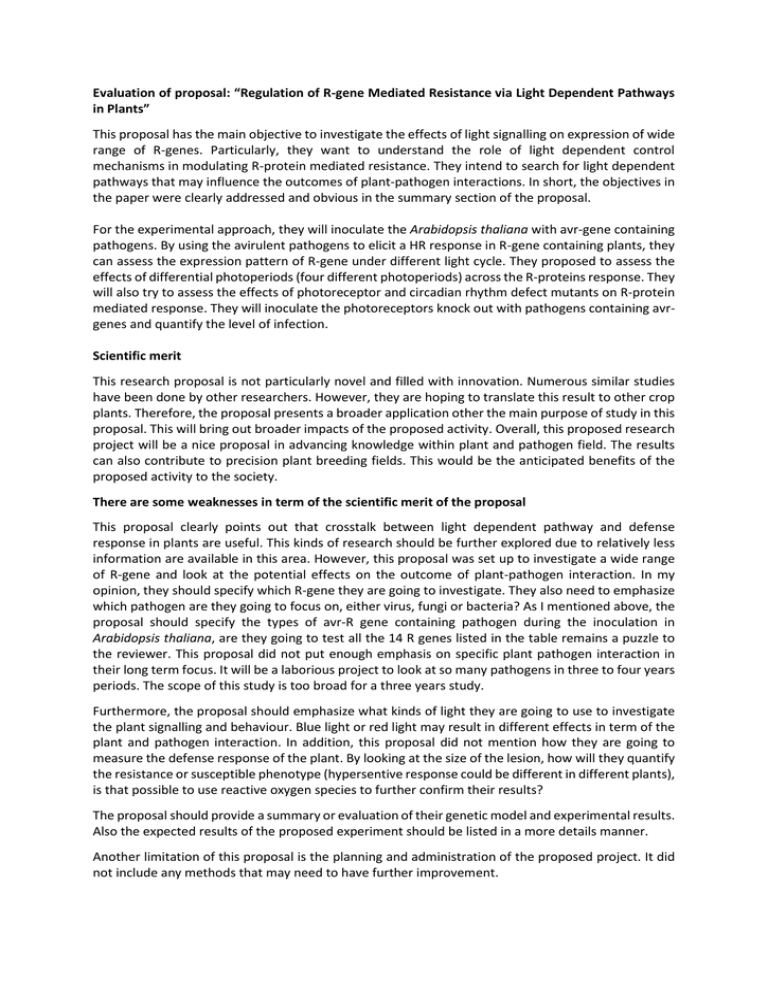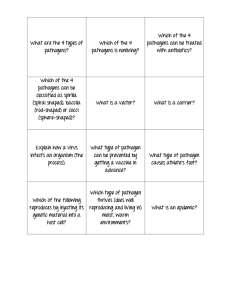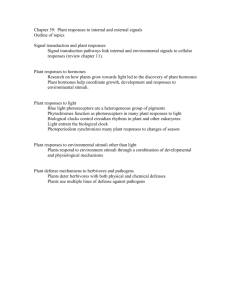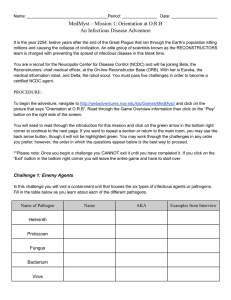Evaluation of proposal: “Regulation of R-gene Mediated Resistance via Light... in Plants”
advertisement

Evaluation of proposal: “Regulation of R-gene Mediated Resistance via Light Dependent Pathways in Plants” This proposal has the main objective to investigate the effects of light signalling on expression of wide range of R-genes. Particularly, they want to understand the role of light dependent control mechanisms in modulating R-protein mediated resistance. They intend to search for light dependent pathways that may influence the outcomes of plant-pathogen interactions. In short, the objectives in the paper were clearly addressed and obvious in the summary section of the proposal. For the experimental approach, they will inoculate the Arabidopsis thaliana with avr-gene containing pathogens. By using the avirulent pathogens to elicit a HR response in R-gene containing plants, they can assess the expression pattern of R-gene under different light cycle. They proposed to assess the effects of differential photoperiods (four different photoperiods) across the R-proteins response. They will also try to assess the effects of photoreceptor and circadian rhythm defect mutants on R-protein mediated response. They will inoculate the photoreceptors knock out with pathogens containing avrgenes and quantify the level of infection. Scientific merit This research proposal is not particularly novel and filled with innovation. Numerous similar studies have been done by other researchers. However, they are hoping to translate this result to other crop plants. Therefore, the proposal presents a broader application other the main purpose of study in this proposal. This will bring out broader impacts of the proposed activity. Overall, this proposed research project will be a nice proposal in advancing knowledge within plant and pathogen field. The results can also contribute to precision plant breeding fields. This would be the anticipated benefits of the proposed activity to the society. There are some weaknesses in term of the scientific merit of the proposal This proposal clearly points out that crosstalk between light dependent pathway and defense response in plants are useful. This kinds of research should be further explored due to relatively less information are available in this area. However, this proposal was set up to investigate a wide range of R-gene and look at the potential effects on the outcome of plant-pathogen interaction. In my opinion, they should specify which R-gene they are going to investigate. They also need to emphasize which pathogen are they going to focus on, either virus, fungi or bacteria? As I mentioned above, the proposal should specify the types of avr-R gene containing pathogen during the inoculation in Arabidopsis thaliana, are they going to test all the 14 R genes listed in the table remains a puzzle to the reviewer. This proposal did not put enough emphasis on specific plant pathogen interaction in their long term focus. It will be a laborious project to look at so many pathogens in three to four years periods. The scope of this study is too broad for a three years study. Furthermore, the proposal should emphasize what kinds of light they are going to use to investigate the plant signalling and behaviour. Blue light or red light may result in different effects in term of the plant and pathogen interaction. In addition, this proposal did not mention how they are going to measure the defense response of the plant. By looking at the size of the lesion, how will they quantify the resistance or susceptible phenotype (hypersentive response could be different in different plants), is that possible to use reactive oxygen species to further confirm their results? The proposal should provide a summary or evaluation of their genetic model and experimental results. Also the expected results of the proposed experiment should be listed in a more details manner. Another limitation of this proposal is the planning and administration of the proposed project. It did not include any methods that may need to have further improvement. Another pitfall of this research proposal is that the timeline was vague in term of specific research work that should be completed in specific time frame. Thus, time allocated for systematic attainment of objectives is not clear cut. They may need to address which R-gene expression is their priority for the study of plant-pathogen interaction. Moreover, they should mention how to utilize the photoreceptors knock out plants to study the plant and pathogen interaction. To assess the effect of photoreceptors, they propose to create CRY1/2 knock out, PHOT1/2 knock out, PHY A/B LUX knock out, the reasons why they choose these receptors should be provided, are there other photoreceptors in plants? What I would have liked to see is that the proposal have filled in these gaps to further their exhaustive research proposal. There are several strengths of the scientific merit in this proposal. In my point of view, using different photoperiod is a good approach, the proposal makes comparison between difference photoperiods [eg. short day(6h light/18hdark); long day(18h light/ 6h dark); constant light(24 light/0 hr dark); no light(0h light/24 dark)], this is good in order to confirm the fluctuation of R-gene in resistance levels in plants. In order to demonstrate the feasibility for research methods, appropriate references are provided in the proposal. Apart from this, as we know, photoreceptors play a critical role in resistance (R) protein-mediated plant defense against virus and bacteria in Arabidopsis. In this proposal, they intend to generate photoreceptor mutants to examine for the effects that light dependent pathways may have R-gene mediated resistance response in plants. These are critical methods in order to understand the role of light-dependent control mechanisms in modulating R-protein mediated response. In overall, the idea of revealing the relationship between light dependent pathway and the defense mechanism is good. However, further details of research approach are needed. The proposal could be further improved by giving the expected outcomes of the proposed experiment. The potential difficulties, limitation of the proposed procedure and alternative approaches should be listed in more details. Therefore, the description of the undertaking suitability and feasibility of methodology in this proposal is not adequate. In brief, the concept of modulation of R-gene in a light dependent manner is good though. The idea of using light dependent pathway to investigate the regulation of R-gene mediated resistance is an applicable idea in this proposal.







